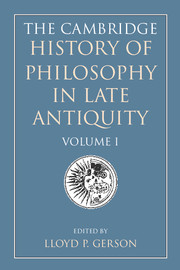Book contents
- Frontmatter
- General introduction
- I Philosophy in the later Roman Empire
- II The first encounter of Judaism and Christianity with ancient Greek philosophy
- III Plotinus and the new Platonism
- IV Philosophy in the age of Constantine
- V The second encounter of Christianity with ancient Greek philosophy
- Introduction to Part V
- 24 Basil of Caesarea
- 25 Gregory of Nyssa
- 26 Gregory of Nazianzus
- 27 Calcidius
- 28 Nemesius of Emesa
- 29 Synesius of Cyrene
- 30 Marius Victorinus
- 31 Augustine
- Map 1 The Byzantine Empire, c. 500
28 - Nemesius of Emesa
from V - The second encounter of Christianity with ancient Greek philosophy
Published online by Cambridge University Press: 28 May 2011
- Frontmatter
- General introduction
- I Philosophy in the later Roman Empire
- II The first encounter of Judaism and Christianity with ancient Greek philosophy
- III Plotinus and the new Platonism
- IV Philosophy in the age of Constantine
- V The second encounter of Christianity with ancient Greek philosophy
- Introduction to Part V
- 24 Basil of Caesarea
- 25 Gregory of Nyssa
- 26 Gregory of Nazianzus
- 27 Calcidius
- 28 Nemesius of Emesa
- 29 Synesius of Cyrene
- 30 Marius Victorinus
- 31 Augustine
- Map 1 The Byzantine Empire, c. 500
Summary
Nemesius was a Christian bishop of Emesa, a major city of the Roman province of Phoenicia Libani, in the territory of Syria. Of him we know only that he is the author of a fully extant work entitled Peri phuseōs anthrōpou (On the Nature of Man), universally known in the West by its Latin title De natura hominis. Its date of composition, derivable from historical-cultural references in the text, can very likely be placed between the end of the fourth century and the earliest years of the fifth century. The attribution of this work to Nemesius, bishop of Emesa, is a fact which nowadays no one doubts, since such a heading is found in a number of manuscripts. Indeed, since the sixth century Nemesius has been explicitly identified as the author of the De natura hominis, although for a time – in the ninth century and for a few centuries after – it was thought to have been written by Gregory of Nyssa. With this prestigious (and false) attribution, the work was known to Latin scholastics such as Albertus Magnus, Peter Lombard and Thomas Aquinas. The first Latin translation of the work is by Alfanus (1015–1085), archbishop of Salerno and author of medical writings. He assigns to the text the title Premnon phusikōn, translated into Latin as Stipes naturalium (The Stem of Natural Things).
- Type
- Chapter
- Information
- The Cambridge History of Philosophy in Late Antiquity , pp. 509 - 519Publisher: Cambridge University PressPrint publication year: 2000

